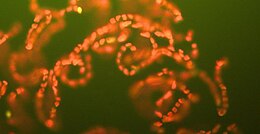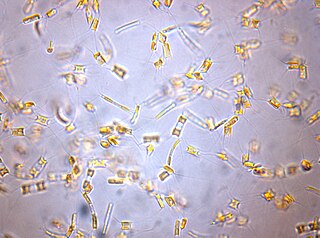
Attheya is a genus of small single celled diatoms. Some of these species were earlier regarded to belong to Chaetoceros, or to Gonioceros, the taxonomic status of some of these species are still debated.

Bacteriastrum is a genus of diatoms in family Chaetocerotaceae. There are more than 30 described species in genus Bacteriastrum, but many of these are not currently accepted, and new species are still added to the genus. The type species for the genus is Bacteriastrum furcatum Shadbolt.
Craticula is a genus of diatom that lies on or in the top layers of sediments in the freshwater to brackish water environments it inhabits. In addition to frustule morphology the genus differs from closely related species by its sexual reproduction and movement in response to light.

Bacillariaceae is a family of diatoms in the phylum Heterokontophyta, the only family in the order Bacillariales. Some species of genera such as Nitzchia are found in halophilic environments; for example, in the seasonally flooded Makgadikgadi Pans in Botswana.

Peridinium is a genus of motile, marine and freshwater dinoflagellates. Their morphology is considered typical of the armoured dinoflagellates, and their form is commonly used in diagrams of a dinoflagellate's structure. Peridinium can range from 30 to 70 μm in diameter, and has very thick thecal plates.
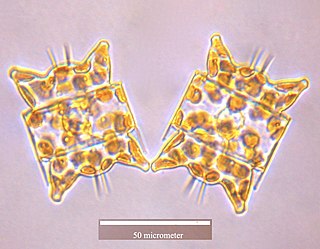
Eupodiscaceae is a diatom family (Bacillariophyceae) present both in marine and freshwater habitats Odontella is the only genera in this family with typical marine species. However, Round et al. (1990) placed Odontella in Triceratiaceae (Schutt) Lemmermann, order Triceratiales Round and Crawford, subclass Biddulphiophycidae Round and Crawford. The taxonomic status of this family is unclear and disputed.
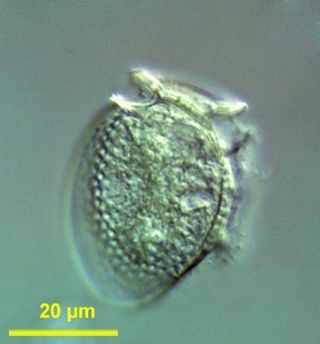
Dinophysis is a genus of dinoflagellates common in tropical, temperate, coastal and oceanic waters. It was first described in 1839 by Christian Gottfried Ehrenberg.

Amphora is a major genus of marine and freshwater diatoms. With over 1000 species, it is one of the largest genera of diatoms. These diatoms are recognized by their strongly dorsiventral frustules, which means that their ridges lie close to the ventral margin of the valve, and their girdle is much wider on the dorsal side.
Thalassiosira weissflogii is a species of centric diatoms, a unicellular microalga. It is found in marine environments and also in inland waters in many parts of the world. It is actively studied because it may use C4-plant style strategies to increase its photosynthetic efficiency.

Tripos is a genus of marine dinoflagellates in the family Ceratiaceae. It was formerly part of Ceratium, then separated out as Neoceratium, a name subsequently determined to be invalid.

Eunotiaceae is a family of diatoms in the order Eunotiales that includes the following genera:

Biddulphiaceae is a family of diatom in the order Biddulphiales. The Biddulphiaceae are distinguished from the Eupodiscaceae by their pseudocelli, where the Eupodiscaceae have fully developed ocelli. Both families commonly inhabit the littoral zone of the ocean, close to the shore. Sixteen species of Biddulphiaceae are found on the west coast of India.
Stauroneis is a genus of diatoms (Bacillariophyta) with species that occur in fresh and marine water.
Thalassiothrix is a genus of Chromista belonging to the family Thalassionemataceae.
Detonula is a genus of diatoms belonging to the family Thalassiosiraceae.

Diploneis is a genus of diatoms belonging to the family Diploneidaceae.

Gomphonema is a genus of diatoms belonging to the family Gomphonemataceae.
Lithodesmium is a genus of diatoms belonging to the family Lithodesmiaceae.
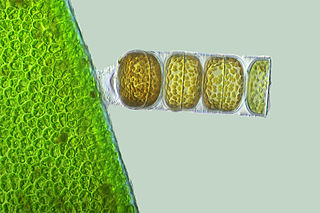
Melosira is a genus of diatoms belonging to the family Melosiraceae.
Leptocylindrus is a genus of diatoms belonging to the family Leptocylindraceae. They are long, cylindrical diatoms that are made up of multiple cells in a line. These cells have chloroplast to allow it to produce energy through photosynthesis by taking in sunlight and carbon dioxide to create sugars. the cells are attached at the cell walls called valves, the cell wall is slightly concave on one side and convex on the other so that the other cell wall attached will fit together.

